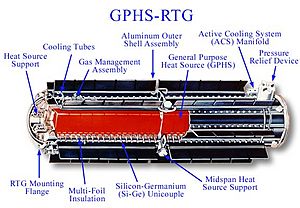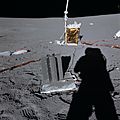Radioisotope thermoelectric generator facts for kids
An RTG (short for Radioisotope Thermoelectric Generator) is a special kind of power source. It makes electricity from the heat given off by certain radioactive materials as they slowly break down. Think of it like a tiny, long-lasting nuclear battery that has no moving parts!
RTGs are very useful for powering things in space, like satellites and space probes. They are also used in places on Earth where it's hard to get power, such as remote lighthouses in the Arctic Circle. These generators are great when you need a little bit of power (a few hundred watts or less) for a very long time, especially where solar cells won't work. This includes places far from the Sun or where there isn't much sunlight.
Contents
How an RTG Works
Turning Heat into Electricity
An RTG creates electricity using something called the thermoelectric effect. This effect happens when two different types of materials are joined together and one side is heated while the other is kept cool. This temperature difference makes electricity flow.
Inside an RTG, special materials called thermocouples are used. One end of the thermocouple gets hot from the radioactive material, and the other end stays cooler. This difference in temperature makes a small electric current. Many thermocouples are put together to make enough power for a spacecraft or remote station.
The Power Source: Radioactive Decay
The heat in an RTG comes from radioactive decay. This is a natural process where unstable atoms slowly change into more stable ones. When they change, they release energy, mostly as heat. The material often used in RTGs is plutonium-238, which is a safe and reliable heat source for many years.
Where RTGs Are Used
Powering Space Missions
RTGs are perfect for space missions that travel far from the Sun, like the Voyager probes or the New Horizons spacecraft that visited Pluto. Solar panels wouldn't work well in these distant, dark places. RTGs can provide power for decades, allowing these probes to keep sending back amazing discoveries.
They have powered many famous missions, including:
- The Cassini probe that explored Saturn.
- The Galileo spacecraft that studied Jupiter.
- The Curiosity and Perseverance rovers on Mars.
Remote Locations on Earth
On Earth, RTGs have been used in very remote and hard-to-reach places. For example, the former Soviet Union used them to power lighthouses and weather stations in the Arctic Circle. These places are often covered in snow and ice, making it difficult to use other power sources or to send people for maintenance.
Safety of RTGs
Keeping Radioactive Material Safe
Because RTGs use radioactive materials, they are built to be very safe. The radioactive material is enclosed in strong, special containers that can withstand extreme conditions, like a rocket launch or even a crash. This makes sure the radioactive material stays contained, even long after the RTG stops producing useful power.
The amount of radioactive material used is small, and the design makes sure it is safely managed throughout the RTG's long life.
Images for kids
-
A pellet of 238PuO2 as used in the RTG for the Cassini and Galileo missions. This photo was taken after insulating the pellet under a graphite blanket for several minutes and then removing the blanket. The pellet is glowing red hot because of the heat generated by radioactive decay (primarily α). The initial output is 62 watts.
-
90Sr-powered Soviet RTGs in dilapidated condition.
-
Inspection of Cassini spacecraft RTGs before launch
-
New Horizons in assembly hall
See also
 In Spanish: Generador termoeléctrico de radioisótopos para niños
In Spanish: Generador termoeléctrico de radioisótopos para niños









